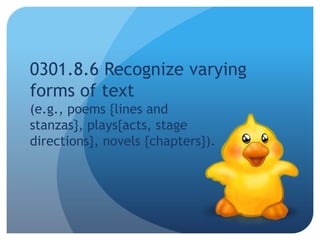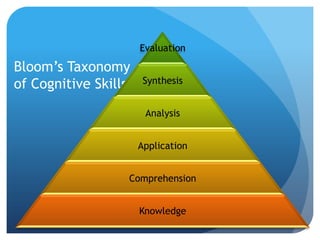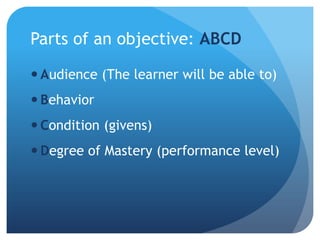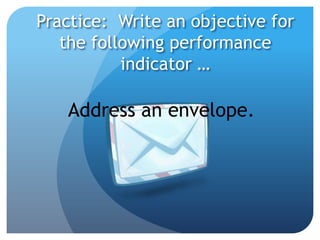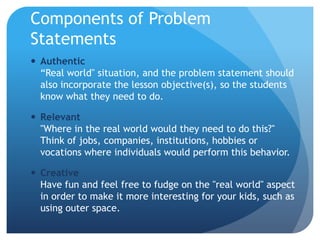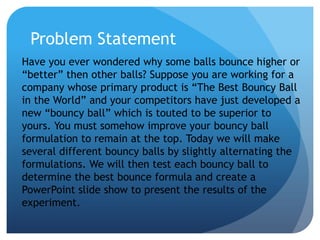Writing Objectives & Problem Statements
- 1. Writing Objectives & Problem Statements RightMichael M. Grant 2010
- 2. Where do they come from?
- 3. NL-ENG.K-12.1 Reading For Perspective Students read a wide range of print and nonprint texts to build an understanding of texts, of themselves, and of the cultures of the United States and the world; to acquire new information; to respond to the needs and demands of society and the workplace; and for personal fulfillment. Among these texts are fiction and nonfiction, classic and contemporary works.
- 4. 0301.8.6 Recognize varying forms of text(e.g., poems {lines and stanzas}, plays{acts, stage directions}, novels {chapters}).
- 5. SPI 0301.8.3 Identify forms of text as poems, plays, or stories.
- 6. Who are objectives for?
- 7. Three Different Types of BehaviorsCognitive (knowledge)Psychomotor (skills)Affective (attitudes)
- 8. Three Different Types of BehaviorsThe cognitive domain is well studied and understood. This is where Bloom’s taxonomy (Benjamin Bloom) comes into play.The psychomotor and affective domains also have levels like Bloom’s but they are more disputed.
- 9. Bloom’s Taxonomy of Cognitive Skills
- 10. Parts of an objective: ABCDAudience (The learner will be able to)BehaviorCondition (givens)Degree of Mastery (performance level)
- 11. Anatomy of an ObjectiveGiven a beach scene picture, the learner will be able to classify the objects into the three states of matterwith 80% accuracy.ConditionAudienceBehaviorDegree of Mastery
- 12. ConcisenessNot all objectives have all the parts.If the performance level is 100%, then it is often left off.Sometimes you see them without the TLWBAT because it’s understood.
- 13. Tip #1Only put one verb in your behavior.If you have two verbs, then you probably have two objectives.The exception is "compare and contrast.”
- 14. Tip #2Don’t use the bad" verbs.Don’t use show, understand, know, demonstrate, do, learn.
- 15. Practice:Write an objective for the following State standard …Explore the relationship between an organism’s characteristics and its ability to survive in a particular environment.
- 16. Practice: Write an objective for the following performance indicator …Address an envelope.
- 18. What’s the point of a problem statement?
- 19. Components of Problem StatementsAuthentic“Real world" situation, and the problem statement should also incorporate the lesson objective(s), so the students know what they need to do. Relevant"Where in the real world would they need to do this?" Think of jobs, companies, institutions, hobbies or vocations where individuals would perform this behavior.CreativeHave fun and feel free to fudge on the "real world" aspect in order to make it more interesting for your kids, such as using outer space.
- 20. Some to get you thinking …Is this the work of a scientist?Does a journalist do this?Would they need to do this at a museum?Is this what an accountant does?Would they need to do this at the farmer's market stand?Is this how your grandmother makes quilts?
- 21. Examples
- 22. ObjectivesThe learner will collect data accurately and organize it into a chart using a clock, "Ice Cube Keeper", digital caliper and worksheet provided by the teacher. The learner will organize data into a line graph in Excel with one mistake or less including titling graph, labeling axis and entering data.
- 23. Problem StatementYou and your family have going camping and want to have somewhere to keep ice and cold soda for a long time. You will not have electricity on this trip and you do not have money to buy a cooler from the store. You want to build an "Ice Cube Keeper" out of materials already in your house. What materials do you think will insulate the cooler enough to keep ice in it? What materials do you think will not work very well? As a class we will test various materials to see which ones keep ice from melting.
- 24. ObjectivesThe learner will write metaphors, similes and hyperboles.The learner will distinguish between metaphors, similes and hyperboles when hearing them.
- 25. Problem StatementThe National Archive Society in Washington DC is looking into organizing and preserving information about your family. They want to have historical records of American families. You will be creating a family tree on a poster board. You will also be making a PowerPoint slideshow about your family. You will present these two items to the National Archive Society (our class) on May 1st. To convince the society that your family’s information deserves the great honor of being in the national archives, you will create 2 metaphors, hyperboles or similes about each member of your immediate family.
- 26. Problem StatementHave you ever wondered why some balls bounce higher or “better” then other balls? Suppose you are working for a company whose primary product is “The Best Bouncy Ball in the World” and your competitors have just developed a new “bouncy ball” which is touted to be superior to yours. You must somehow improve your bouncy ball formulation to remain at the top. Today we will make several different bouncy balls by slightly alternating the formulations. We will then test each bouncy ball to determine the best bounce formula and create a PowerPoint slide show to present the results of the experiment.
- 27. References & AcknowledgementsSome text and slides adapted from Adapted from Albert Ingram, Ph.D., Kent StateMorrison, G.R. & Lowther, D. L. (2009). Integrating computer technology into the classroom (4th ed.). Boston: Pearson.Images from www.Garcya.us/blog
- 28. Michael M. Grant 2010




